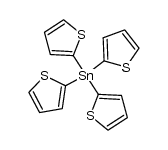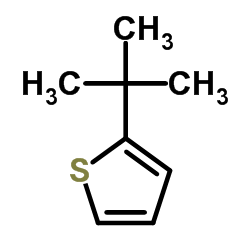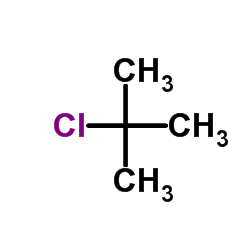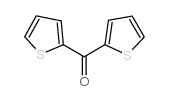5857-39-6
| 英文名 | chloro(thiophen-2-yl)mercury |
|---|---|
| 英文别名 |
Mercury,chloro-2-thienyl
[2]thienylmercury (1+),chloride Chloro(2-thienyl)mercury 2-mercurythiophene 2-HgCl-thiophen 2-Thienylmercuric chloride 2-thienylmercury chloride |
| 分子式 | C4H3ClHgS |
|---|---|
| 分子量 | 319.17500 |
| 精确质量 | 319.93500 |
| PSA | 28.24000 |
| LogP | 1.60970 |
|
Section1. IDENTIFICATION OF THE SUBSTANCE/MIXTURE Product identifiers Product name: 2-(CHLOROMERCURI)THIOPHENE CAS-No.: 5857-39-6 Relevant identified uses of the substance or mixture and uses advised against Identified uses: Laboratory chemicals, Manufacture of substances Section2. HAZARDS IDENTIFICATION Classification of the substance or mixture Classification according to Regulation (EC) No 1272/2008 [EU-GHS/CLP] Acute toxicity, Inhalation (Category 2) Acute toxicity, Dermal (Category 1) Acute toxicity, Oral (Category 2) Specific target organ toxicity - repeated exposure (Category 2) Acute aquatic toxicity (Category 1) Chronic aquatic toxicity (Category 1) Classification according to EU Directives 67/548/EEC or 1999/45/EC Very toxic by inhalation, in contact with skin and if swallowed. Danger of cumulative effects. Very toxic to aquatic organisms, may cause long-term adverse effects in the aquatic environment. Label elements Labelling according Regulation (EC) No 1272/2008 [CLP] Pictogram Signal wordDanger Hazard statement(s) H300Fatal if swallowed. H310Fatal in contact with skin. H330Fatal if inhaled. H373May cause damage to organs through prolonged or repeated exposure. H410Very toxic to aquatic life with long lasting effects. Precautionary statement(s) P260Do not breathe dust/ fume/ gas/ mist/ vapours/ spray. P264Wash hands thoroughly after handling. P273Avoid release to the environment. P280Wear protective gloves/ protective clothing. P284Wear respiratory protection. P301 + P310IF SWALLOWED: Immediately call a POISON CENTER or doctor/ physician. Supplemental Hazardnone Statements According to European Directive 67/548/EEC as amended. Hazard symbol(s) R-phrase(s) R26/27/28Very toxic by inhalation, in contact with skin and if swallowed. R33Danger of cumulative effects. R50/53Very toxic to aquatic organisms, may cause long-term adverse effects in the aquatic environment. S-phrase(s) S13Keep away from food, drink and animal feedingstuffs. S28After contact with skin, wash immediately with plenty of soap and water. S36Wear suitable protective clothing. S45In case of accident or if you feel unwell, seek medical advice immediately (show the label where possible). S60This material and its container must be disposed of as hazardous waste. S61Avoid release to the environment. Refer to special instructions/ Safety data sheets. Other hazards - none Section3. COMPOSITION/INFORMATION ON INGREDIENTS Substances Formula: C4H3ClHgS Molecular Weight: 319,18 g/mol ComponentConcentration 2-(CHLOROMERCURI)THIOPHENE CAS-No.5857-39-6- Index-No.080-004-00-7 Section4. FIRST AID MEASURES Description of first aid measures General advice Consult a physician. Show this safety data sheet to the doctor in attendance. If inhaled If breathed in, move person into fresh air. If not breathing, give artificial respiration. Consult a physician. In case of skin contact Wash off with soap and plenty of water. Take victim immediately to hospital. Consult a physician. In case of eye contact Flush eyes with water as a precaution. If swallowed Never give anything by mouth to an unconscious person. Rinse mouth with water. Consult a physician. Most important symptoms and effects, both acute and delayed To the best of our knowledge, the chemical, physical, and toxicological properties have not been thoroughly investigated. Indication of any immediate medical attention and special treatment needed no data available Section5. FIREFIGHTING MEASURES Extinguishing media Suitable extinguishing media Use water spray, alcohol-resistant foam, dry chemical or carbon dioxide. Special hazards arising from the substance or mixture Carbon oxides, Sulphur oxides, Hydrogen chloride gas, Mercury/mercury oxides. Advice for firefighters Wear self contained breathing apparatus for fire fighting if necessary. Further information no data available Section6. ACCIDENTAL RELEASE MEASURES Personal precautions, protective equipment and emergency procedures Wear respiratory protection. Avoid dust formation. Avoid breathing vapors, mist or gas. Ensure adequate ventilation. Evacuate personnel to safe areas. Avoid breathing dust. Environmental precautions Prevent further leakage or spillage if safe to do so. Do not let product enter drains. Discharge into the environment must be avoided. Methods and materials for containment and cleaning up Pick up and arrange disposal without creating dust. Sweep up and shovel. Keep in suitable, closed containers for disposal. Reference to other sections For disposal see section 13. Section7. HANDLING AND STORAGE Precautions for safe handling Avoid contact with skin and eyes. Avoid formation of dust and aerosols. Provide appropriate exhaust ventilation at places where dust is formed. Conditions for safe storage, including any incompatibilities Store in cool place. Keep container tightly closed in a dry and well-ventilated place. Specific end uses no data available Section8. EXPOSURE CONTROLS/PERSONAL PROTECTION Control parameters Components with workplace control parameters Exposure controls Appropriate engineering controls Avoid contact with skin, eyes and clothing. Wash hands before breaks and immediately after handling the product. Personal protective equipment Eye/face protection Face shield and safety glasses Use equipment for eye protection tested and approved under appropriate government standards such as NIOSH (US) or EN 166(EU). Skin protection Handle with gloves. Gloves must be inspected prior to use. Use proper glove removal technique (without touching glove's outer surface) to avoid skin contact with this product. Dispose of contaminated gloves after use in accordance with applicable laws and good laboratory practices. Wash and dry hands. The selected protective gloves have to satisfy the specifications of EU Directive 89/686/EEC and the standard EN 374 derived from it. Body Protection Complete suit protecting against chemicals, The type of protective equipment must be selected according to the concentration and amount of the dangerous substance at the specific workplace. Respiratory protection Where risk assessment shows air-purifying respirators are appropriate use a full-face particle respirator type N100 (US) or type P3 (EN 143) respirator cartridges as a backup to engineering controls. If the respirator is the sole means of protection, use a full-face supplied air respirator. Use respirators and components tested and approved under appropriate government standards such as NIOSH (US) or CEN (EU). Section9. PHYSICAL AND CHEMICAL PROPERTIES Information on basic physical and chemical properties a) AppearanceForm: solid b) Odourno data available c) Odour Thresholdno data available d) pHno data available e) Melting point/freezingno data available point f) Initial boiling point and no data available boiling range g) Flash pointno data available h) Evaporation rateno data available i) Flammability (solid, gas) no data available j) Upper/lowerno data available flammability or explosive limits k) Vapour pressureno data available l) Vapour densityno data available m) Relative densityno data available n) Water solubilityno data available o) Partition coefficient: n- no data available octanol/water p) Autoignitionno data available temperature q) Decompositionno data available temperature r) Viscosityno data available s) Explosive propertiesno data available t) Oxidizing propertiesno data available Other safety information no data available Section10. STABILITY AND REACTIVITY Reactivity no data available Chemical stability no data available Possibility of hazardous reactions no data available Conditions to avoid no data available Incompatible materials Strong oxidizing agents Hazardous decomposition products Section11. TOXICOLOGICAL INFORMATION Information on toxicological effects Acute toxicity no data available Inhalation: no data available Dermal: no data available Skin corrosion/irritation no data available Serious eye damage/eye irritation no data available Respiratory or skin sensitization no data available Germ cell mutagenicity no data available Carcinogenicity IARC:No component of this product present at levels greater than or equal to 0.1% is identified as probable, possible or confirmed human carcinogen by IARC. Reproductive toxicity no data available Specific target organ toxicity - single exposure no data available Specific target organ toxicity - repeated exposure Causes damage to organs through prolonged or repeated exposure. Aspiration hazard no data available Potential health effects InhalationMay be fatal if inhaled. May cause respiratory tract irritation. IngestionMay be fatal if swallowed. SkinMay be fatal if absorbed through skin. May cause skin irritation. Eyes May cause eye irritation. Signs and Symptoms of Exposure To the best of our knowledge, the chemical, physical, and toxicological properties have not been thoroughly investigated. Additional Information RTECS: Not available Section12. ECOLOGICAL INFORMATION Toxicity no data available Persistence and degradability no data available Bioaccumulative potential no data available Mobility in soil no data available Results of PBT and vPvB assessment no data available Other adverse effects Very toxic to aquatic life. no data available Section13. DISPOSAL CONSIDERATIONS Waste treatment methods Product Offer surplus and non-recyclable solutions to a licensed disposal company. Dissolve or mix the material with a combustible solvent and burn in a chemical incinerator equipped with an afterburner and scrubber. Contaminated packaging Dispose of as unused product. Section14. TRANSPORT INFORMATION UN number ADR/RID: 2811IMDG: 2811IATA: 2811 UN proper shipping name ADR/RID: TOXIC SOLID, ORGANIC, N.O.S. (2-(CHLOROMERCURI)THIOPHENE) IMDG: TOXIC SOLID, ORGANIC, N.O.S. (2-(CHLOROMERCURI)THIOPHENE) IATA:Toxic solid, organic, n.o.s. (2-(CHLOROMERCURI)THIOPHENE) Transport hazard class(es) ADR/RID: 6.1IMDG: 6.1IATA: 6.1 Packaging group ADR/RID: IIIMDG: IIIATA: II Environmental hazards ADR/RID: noIMDG Marine pollutant: noIATA: no Special precautions for user no data available Section15. REGULATORY INFORMATION This safety datasheet complies with the requirements of Regulation (EC) No. 1907/2006. Safety, health and environmental regulations/legislation specific for the substance or mixture no data available Chemical Safety Assessment no data available Section16. OTHER INFORMATION Further information Copyright 2012 Co. LLC. License granted to make unlimited paper copies for internal use only. The above information is believed to be correct but does not purport to be all inclusive and shall be used only as a guide. The information in this document is based on the present state of our knowledge and is applicable to the product with regard to appropriate safety precautions. It does not represent any guarantee of the properties of the product. Corporation and its Affiliates shall not be held liable for any damage resulting from handling or from contact with the above product. See and/or the reverse side of invoice or packing slip for additional terms and conditions of sale. |
|
~% 
5857-39-6 |
| 文献:Krause; Renwanz Chemische Berichte, 1932 , vol. 65, p. 782 Full Text Show Details Johnson; Van Campen; Grummitt Journal of the American Chemical Society, 1938 , vol. 60, p. 113 |
|
~% 
5857-39-6 |
| 文献:Steinkopf; Bauermeister Justus Liebigs Annalen der Chemie, 1914 , vol. 403, p. 51 Full Text Show Details Finzi Gazzetta Chimica Italiana, 1915 , vol. 45 II, p. 283 |
|
~% 
5857-39-6 |
| 文献:Krause; Renwanz Chemische Berichte, 1932 , vol. 65, p. 782 |









